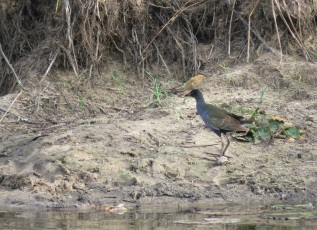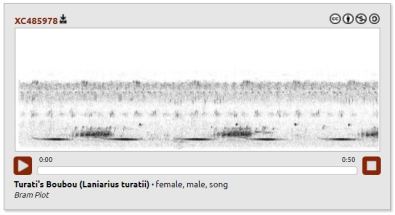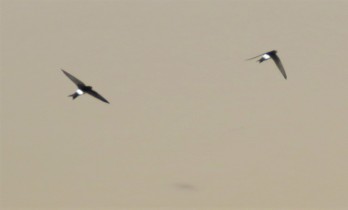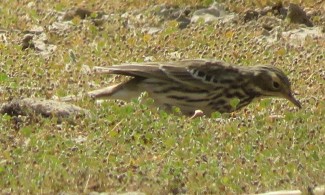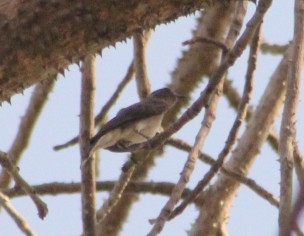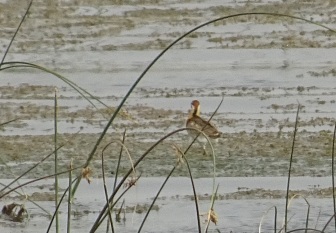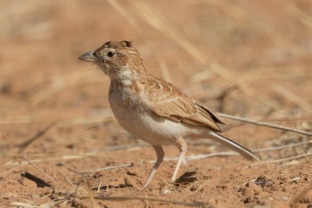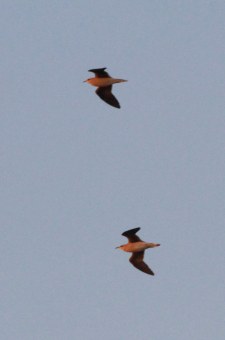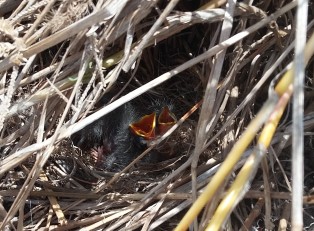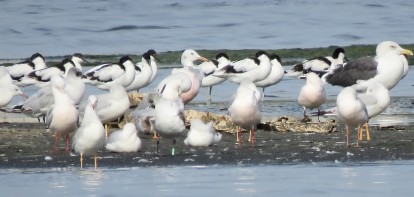Turati’s Boubou new to Senegal, and other recent records from Casamance

Last month I was lucky to be able to sneak out to Casamance for a few days, a region I hadn’t visited since May 2017 when I paid a brief visit to Kolda. Together with Bruno Bargain, resident birder in Ziguinchor, we explored several areas and managed to see a good number of interesting birds. But before going through the highlights of our trip, it’s about time we gave a few more details about the discovery of a new species for Senegal: Turati’s Boubou, found last October by Bruno near Ziguinchor. This West African endemic appears to be resident in small numbers in at least one locality, but it’s likely that it is actually well established in a few other forests of Basse-Casamance.
This latest addition to the national list was expected, so not a big surprise – but still significant, given that this species was so far only known to occur in Guinea-Bissau, Guinea and Sierra Leone. Our assumption that it should be present in Casamance was based on the fact that the species is present just across the border in northern Guinea-Bissau, and that suitable habitat exists in Basse-Casamance which up to recently was one of the least well known regions, ornithologically speaking, of Senegal. A member of the Malaconotidae, Turati’s Boubou is not uncommon within its restricted range, but its secretive habits make it difficult to find – something I experienced first-hand last month when trying to catch a glimpse of one of the Ziguinchor birds: impossible! Outside of the breeding season (likely just before and during the rains, i.e. May/June – October) they don’t appear to be very vocal and don’t necessarily respond to playback. We heard at least two birds singing briefly – a typical ghost-like boubou song – and while at one point one bird was calling just a few meters away in dense undergrowth at the edge of a remnant forest patch, it just did not want to show itself. Next time! The only recording I managed to obtain was of this call, which when we first heard it was a perfect match of the call recorded by Ron Demey in western Guinea, assumed to be that of a female (included in Claude Chappuis’s CD set). Bruno so far obtained just a single picture but was lucky to get good views of several birds, including an supposed pair (at least three different birds have been found since the first sighting on October 10th. Update 13.02: here’s a picture taken just this morning by Bruno, after an hour of patiently waiting for the bird to show…
More field work is of course needed to get a better sense of this little known species’ breeding cycle, distribution and population size in Casamance; I certainly hope to be able to contribute to this effort in coming months. So for now, here’s just a picture of the habitat in which these birds were found: note the dense undergrowth in otherwise fairly open, dry forest.
Of note is that there is at least one unsubstantiated record of Tropical Boubou in Casamance and as a result the species is often listed – incorrectly in my view – as occurring in Senegal: this sighting may in fact relate to Turati’s Boubou which Tropical resembles fairly closely. Even its vocalisations are extremely similar – Chappuis wrote that “it is barely possible to distinguish the two species acoustically” – so it wouldn’t be surprising were this actually Turati’s.
Another target of my short trip was Western Square-tailed Drongo, aiming to obtain sound recordings of this newly described cryptic species which is now included in the reference list maintained by the International Ornithological Committee (IOC 9.1) as a valid species, Dicrurus occidentalis. More on this discovery in this recent blog post. The latest IOC list, published just last week, also includes another taxonomic change in the Dicruridae that affects the Senegal list: the two subspecies of Fork-tailed Drongo D. adsimilis ranging from west to north-central Africa are now elevated to Glossy-backed Drongo D. divaricatus (Fork-tailed Drongo sensu strictu is found in central, eastern and southern Africa). More on the recent taxonomic revisions in a later post…
Anyway, back to Casamance: thanks to Bruno’s excellent field knowledge, we easily found Western Square-tailed Drongo in two locations, and several decent recordings were obtained. While more material is needed, we hope that these will eventually contribute to further our knowledge of vocal differences between occidentalis and its “sister species” Sharpe’s Drongo D. sharpei. As usual, my recordings can be found here on xeno-canto.
During our 72 hours in the field (16-19.01), we specifically targeted a few sites in atlas squares with no or very few records so far, particularly in the area between Bignona and Tionck-Essil where we spent one night in a campement villageois (more on the Casamance bird atlas further down and in this article). All in all we collected close to 400 records of some 175 species, which just highlights the richness of Basse-Casamance.
Birding from dawn to dusk – brilliant!
In addition to the boubou and drongo, some of the highlights were Spotted Honeyguide (lifer! recording of its distinctive song here), Ovambo Sparrowhawk (poorly known and rarely reported species in Senegal), Woolly-necked Stork (a bird flying in from mangroves near Elana), great views and good recordings of Ahanta Francolin which seems to be far more widespread and less of a forest specialist than field guides suggest. And of course, a range of other typical forest species that in Senegal are largely restricted to this part of the country: Buff-spotted Woodpecker, Piping Hornbill, Grey-hooded Capuchin Babbler, Green Crombec, Green Hylia, Little Greenbul, Guinea Turaco, Grey-headed Bristlebill, Puvel’s Illadopsis, Olive Sunbird, etc. (Indicateur tacheté, Epervier de l’Ovampo, Cigogne épiscopale, Francolin de l’Ahanta, Pic tacheté, Calao siffleur, Phyllanthe capucin, Crombec vert, Hylia verte, Bulbul verdâtre, Touraco vert, Bulbul fourmilier, Akalat de Puvel, Souimanga olivâtre).
Obtaining good views – or any views at all for that matter – of these forest specials was often difficult, so I don’t really have any good pictures to share. The two below illustrate quite well how challenging this can be in the forest, especially with my bottom-of-the-range camera:

A blurry Red-bellied Paradise Flycatcher / Tchitrec à ventre roux, a fairly common forest dweller in Casamance
A few scarce Palearctic migrants were seen, including Booted Eagle, European Bee-eater, House Martin, Grasshopper Warbler – the latter in dense grasses on the edge of dry rice paddies near Ziguinchor, a rare record this far south although the species is probably regular in winter (Aigle botté, Guêpier d’Europe, Hirondelle de fenetre, Locustelle tachetée).
This African Pygmy Goose was one of at least nine birds seen on a pond close to those same extensive rice paddies, where they seem to have bred. Other birds in this area, which we visited late afternoon on my first day in town, included Giant Kingfisher, Purple Heron, Piping Hornbill, Quailfinch, Lanner, Whinchat, and so on (Martin-pêcheur géant, Héron pourpré, Calao siffleur, Astrild-caille, Faucon lanier, Tarier des prés).
Similar habitat often holds pairs of Abyssinian Gound Hornbill which appears to still pretty common in Casamance, allowing me to finally see this impressive bird – by some considered to be one of the ugliest birds roaming our planet, though I beg to differ! – which somehow had managed to elude me so far in Senegal. I’d only ever seen it in Awash NP in the Ethiopian Rift Valley, many years ago… We found a small family group feeding in fields just east of Bignona, and another two birds a few kilometers further along the road to Elana. In the end I saw or heard several birds I hadn’t seen before in Senegal, including 4 lifers, bringing my country list to 507 species by the end of the trip. With the addition of Turati’s Boubou, the national list now stands at 677.
I’d like to highlight once again the fabulous work that Bruno and colleagues from the APALIS association are doing in Casamance: with very limited means – but with a great deal of passion and perseverance – they are slowly but surely putting together a comprehensive picture of the distribution and abundance of birds across the region, currently covering some 450 species. Not an easy feat considering how remote and inaccessible many parts of this remarkable region of Senegal are; Casamance is arguably the most diverse and in many ways the most pleasant and most exciting part of the country, and I for one certainly wish I were able to spend more time there. The latest APALIS newsletter (in French, available here as a PDF) contains multiple interesting records and new discoveries, such as the first records in nearly 40 years in the region of White-crested Tiger Heron (with a brilliant picture!), Senegal Lapwings (six near Kamobeul on 30.9.18; despite its name this is a real rarity in Senegal!), and Winding Cisticola; the first regional records of Glossy Ibis, Sun Lark, Singing Bush Lark, Brown-throated Martin, Great Reed Warbler, confirmed breeding of White-backed Night-Heron, and much more (Onoré à huppe blanche, Vanneau terne, Cisticole du Nil, Ibis falcinelle, Cochevis modeste, Alouette chanteuse, Hirondelle paludicole, Rousserolle turdoïde, Bihoreau à dos blanc). The most significant records will be included in the next “Recent Reports” of the African Bird Club bulletin, to be published in March.
In addition to the routine atlassing field work, our friends are now embarking on a project to survey some of the main heronries and other water bird colonies, using a drone to take aerial pictures of the colonies located in dense inaccessible mangroves, thus enabling estimates of the number of nests for each species. The association is currently raising funds to finance the purchase and operating costs of the drone, so please chime in, every bit helps! Link to fundraising campaign here. And please consider supporting APALIS by becoming a member, which at just 15 Euros is just a, well, bargain 😉
And of course, if you have the opportunity to visit Casamance, please get in touch so we can make sure that your observations get incorporated into the database; Bruno can offer advice about where to go or which birds to target more specifically. Nearly three times the size of Gambia, with a good range of different habitats represented, there’s something for everyone. Any birder coming to Senegal should definitely consider visiting this region, and more generally try to get off the beaten birding track – forget about Djoudj, Richard Toll, the Saloum or even Wassadou (and yes even Technopole): Casamance is the place to be!
Enfin, un grand merci à Bruno et sa petite famille pour l’accueil à Kantène!
Year in review: 2018
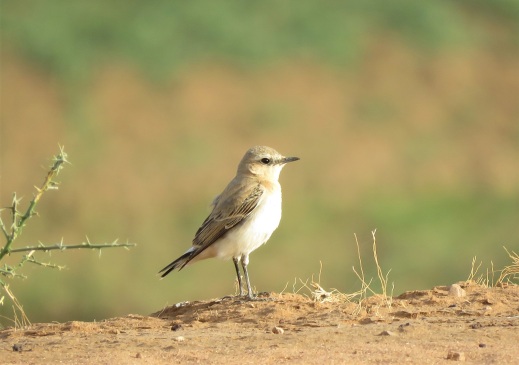
Just like last year we’re bringing our readers a summary of the past year, reviewing some of the ornithological highlights and discoveries made in Senegal, and recycling some of the pictures and posts that appeared on this website during the past 12 months.
2018 certainly has been a busy year!
We’ll start with the best of all: the discovery of what appears to be an isolated (?) population of Horus Swifts (Martinet horus), some 3,000 km from the nearest known breeding sites and more than 1,600 km from the nearest observations of the species (in northern Ghana). This is probably one of the least expected range extensions uncovered in West Africa in recent years, and something we’re of course quite excited (and rather proud!) of. We found these birds during an epic 4-day trip up north together with Frédéric Bacuez and visiting birder Filip Verroens from Belgium, in early January. Needless to say, the year started off with a bang! Read up the full story here and on Frédéric’s Ornithondar blog (in French). A few of these neat swifts were seen again in February by Frédéric and Daniel Nussbaumer, then in October by Vieux Ngom and myself when some 50 birds were present, again showing signs of local breeding and confirming that these birds are most likely residents here, and just last week a group of visiting American birders saw about 25 birds at Gamadji Sare.
Just a few days earlier, in fact on the first day of the year, we’d already found another species new to Senegal: a Meadow Pipit (Pipit farlouse) at the Yene-Tode lagoon just south of Dakar. This find was a bit more controversial – but probably more expected than those swifts! – in the sense that the pipit shows a fairly unusual plumage for Meadow Pipit and certain characters fit Red-throated Pipit better. However, the unstreaked rump and especially the diagnostic call, which was heard loud & clear several times at close range (but unfortunately not sound-recorded), safely rule out Red-throated Pipit, several of which were present in the area at the same time. Full story, description and many pictures here.
Continuing on the same theme, this past year saw the addition of two more species to the Senegal list: Brown-backed Honeybird – which had already been reported from Wassadou in 2015 but was not documented – and Turati’s Boubou. The former was found by Gabriel Caucanas and friends first at Dindefelo, then at Wassadou and later in the Niokolo-Koba NP (more info here), the latter by resident Casamance birder Bruno Bargain back in October. Both were more or less to be expected and back in July we’d actually predicted that the boubou would be found in Casamance some time soon, given that it is known to occur just across the border in Guinea-Bissau. We’ll write up more about this species in due course, and I hope to soon visit the Ziguinchor area again and see (and record) this little-known species – stay tuned!
With no less than four new species, 2018 definitely boosted the national list which now stands at a respectable 678 species; more on this in a blog piece we wrote on the topic of the national list, which contains a link to a handy spreadsheet with all species seen in Senegal, with English, French and scientific names.
Of course there were also the usual lot of vagrants, mostly Nearctic waders in the Dakar region and especially at Technopole, pretty much as usual!
- Common Shelduck (Tadorne de Belon): eight in the Djoudj NP on 17/1 were likely the same group as seen in the Diawling just across the border in Mauritania on 30/12, while one at Technopole on 18-19/2/18 confirmed the small influx that occurred during the ‘17/’18 winter: 8th and 9th records!
- Red-footed Booby (Fou à pieds rouges): one was photographed at Iles de la Madeleine on 26/1 but was only identified later on, while at Ngor up to two adults were seen on several occasions in spring (17/5-22/5, and again on 11 and 22/6) and one was seen twice in autumn (13 & 15/11). These are the 2nd to 4th records for this tropical seabird, which was seen for the first time in October 2016 only.
- Cinereous (=Black) Vulture (Vautour moine): an imm. west of Fatick on 30/1 and one (different bird) on 26/2 near Sagata, east of Kebemer. These observations coincide with the first records for The Gambia (Feb. ‘18) and Mauritania (Dec. ‘17). We also reported the first record of the species, which had not yet been published so far – more details on the status of this increasing Palearctic vagrant in this piece.
- American Golden Plover (Pluvier bronzé): one at Technopole on 8 April, followed by two autumn birds, at lac Mbeubeusse on 3/11 and barely a week later a different bird at Pointe Sarene near Nianing on 9-10/11. Read more on this species in Senegal here.
- European Golden Plover (Pluvier doré): one at Île de Saloulou (Basse Casamance) on 3/1.
- Lesser Yellowlegs (Chevalier à pattes jaunes): the 8th record was one at Technopole seen by a visiting birder on 8/2 and relocated on 19/2
- Baird’s Sandpiper (Bécasseau de Baird): the second for Senegal (and first properly documented) was found at Technopole on 25/3 and seen again on 8/4.
- Buff-breasted Sandpiper (Bécasseau rousset): two birds stayed for a remarkably long time at Technopole, being present from 13/1 (at least one) up to 19/2 at least, then again on 25/3 though this was probably a new bird given that regular visits earlier in the month failed to relocate the two long-stayers; these are the 8th and 9th records.
- Red-necked Phalarope: (Phalarope à bec étroit): one at Djoudj on 27/2 is the 6th record at least, though it’s quite possible that the species is a more regular visitor than the handful of confirmed records suggest.
- Franklin’s Gull (Mouette de Franklin): one was seen five times between 20/5 and 20/9 at Technopole; we summarised the status and trends of the species in this post.
As usual there are also several African vagrants to be reported, such as Lesser Jacana (Jacana nain) seen on 31/1 and 17/2 (three birds!) at Médina Afia near Manda, Kolda dept., and at Ross Bethio on 15/7 – there are only a handful of previous records, including just one in the north (more on status of this species in this post by Ornithondar). A Pharaoh (= Desert) Eagle-Owl (Grand-duc ascalaphe) filmed at Richard Toll on 20/1 was the third record. Six Senegal Lapwings were found at Kamobeul (Ziguinchor) on 30/9 – apparently the first record in 38 years! Three other species with uncertain status in Senegal – true vagrants or scarce but regular visitors? – were seen in the Niokolo-Koba area: Mottled Swift in February and June; a Forbes’s Plover in June and an Ayres’s Hawk-Eagle on 6/3 (Martinet marbré, Pluvier de Forbes et Aigle d’Ayres) .
A special mention goes to the Kordofan Lark (Alouette du Kordofan) that was photographed at Richard Toll on 1/3 by a group of lucky Belgian birders; this is the first record in several years, and the first pictures to be made available online for this species, prompting us to discuss ID criteria and status in Senegal of this enigmatic Sahel special, see this blog piece co-authored with Simon Cavaillès – by far the most read article on the blog, with more than 500 views since its publication in April.
Several winter visitors were seen in higher than usual numbers or reached areas further south than their usual wintering grounds, such as Short-eared Owl (Hibou des marais; seen in six locations during January-March including a group wintering at Technopole, following the influx in Nov.-Dec.). Other scarce winter visitors included a Little Gull (Mouette pygmée) at Ngor on 12/1, while a group of five Cream-coloured Coursers (Courvite isabelle) near Maleme Hodar (Kaffrine) on 1/3 were possibly the southernmost record ever. Other examples include a Spectacled Warbler (Fauvette à lunettes) near Kaolack on 3/3, a “Desert” Grey Shrike (now surprisingly lumped again with Great rather than Southern Grey Shrike; Pie-grièche grise) in the Boundou reserve on 15/3, and five House Buntings (Bruant du Sahara) at Richard Toll on 1/3.
As usual, a few birds were spotted outside of their regular range in the country: several Pallid Herons on the Cap-Vert peninsula; an African Hawk-Eagle that gave us a bit of an ID challenge at Popenguine (3/11); a Greyish Eagle-Owl photographed at Trois-Marigots on 10/1 (only a couple of previous records from N Senegal, see story on Ornithondar); a Grey Phalarope on 25/2 at Médina Afia (a rare inland record!); a singing Klaas’s Cuckoo near Dagana on 6/10; a Broad-billed Roller at Bango (Saint-Louis) on 31/8; Grey-rumped Swallow at Technopole (7/7); an early Lesser Whitethroat at lake Tanma on 25/9; a Cricket Warbler near Gueuol (north of Kébémer) on 21/11 (Aigle fascié, Grand-duc du Sahel, Phalarope à bec large, Coucou de Klaas, Rolle violet, Hirondelle à croupion gris, Fauvette babillarde, Prinia à front écailleux). In the Djoudj, a Brown Snake-Eagle was reported on 5/12. Familiar Chat and Green Turaco were reported from the Niokolo-Koba NP for the first time, where further observations of Mali Firefinch were made (Traquet familier, Turaco vert, Amarante du Koulikoro). Several species were found for the first time in Casamance, including Glossy Ibis, Singing Bushlark, Plain Martin, Great Reed Warbler – details will follow shortly on this website (Ibis falcinelle, Alouette chanteuse, Hirondelle paludicole, Rousserolle turdoïde). Away from the better known wintering grounds in the north of the country, an Iberian Chiffchaff (Pouillot ibérique) was singing at Wassadou on 25/2, and the Technopole bird found on 31/12/17 continued its presence until 7/1 at least.
New breeding records include what appears to be the first confirmed breeding for the Dakar region of Little Tern in June at Lac Rose with at least 14 nests; in the same location we found a nest of Plain-backed Pipit, while a Quailfinch at lac Mbeubeusse on 18/11 suggests that the species may be breeding in the niayes region (Sterne naine, Pipit à dos uni, Astrild-caille). Successful breeding of White-backed Night-Herons (Bihoreau à dos blanc) was confirmed in two locations in Casamance and breeding is also likely along the Gambia river at Wassadou where Pel’s Fishing Owl (Chouette-pêcheuse de Pel) must also have bred. Black-winged Stilts (Echasse blanche) bred once again at Technopole where low water levels created decent conditions in April-June. And a nice breeding record was that of a female Standard-winged Nightjar found incubating two eggs at Pointe Sarène on 4/8 (Engoulevent à balanciers).
A few unseasonal visitors were noted, e.g. early Marbled Ducks and a Black-necked Grebe near Djoudj on Oct. 6th, Western Olivaceous and Melodious Warblers as well as a Woodchat Shrike and even two European Bee-eaters in June; an adult Sabine’s Gull at Ngor on 30/7 (first July record it seems?), and summer Yellow-legged Gulls at Lac Rose (Sarcelle marbrée, Grèbe à cou noir, Hypolaïs obscure et polyglotte, Pie-grièche à tête rousse, Guêpier d’Europe, Mouette de Sabine, Goéland leucophée). Up north, a White-throated Bee-eater and a Pygmy Sunbird were photographed in January near Saint-Louis (Guêpier à gorge blanche, Souïmanga pygmée).
We also continued our seabird migration monitoring efforts during 2018, both in spring and in autumn. Spring migration was summarised in two posts (covering April and May) but the autumn totals are yet to be published. Highlights included decent numbers of Long-tailed Skua (500!) and Grey Phalaropes (1,256!) seen in August when fairly strong north-westerlies created ideal conditions to see these highly pelagic migrants from the coast; both species saw new day records for West Africa it seems. Other good ones included at least 19 Barolo/Boyd’s Shearwaters in Aug.-Sept., a Sooty Tern on 17/9 and several Bridled Terns, while Great Shearwaters passed through in modest numbers around mid-November (Puffin de Barolo/Macaronésie, Sterne fuligineuse, Sterne bridée, Puffin majeur). A pelagic trip on October 1st yielded reasonable numbers of Wilson’s Storm-Petrels (Océanite de Wilson), some shearwaters and skuas, but no rarities this time round. A visiting birder was lucky to see a White-faced Storm Petrel on 3/12 at Iles de la Madeleine, while an observation of Band-rumped Storm Petrel was reported far offshore off Saint-Louis on 25/9 (Océanites frégate et de Castro).
On the ring recovery front, we managed to read some 100 colour rings, mainly of Audouin’s and Slender-billed Gulls (41 & 19, resp.) but also several Greater Flamingos from Spain, a Common Ringed Plover from Portugal, and the first mentions of Avocet in our database (two birds from Spain) as well as a French Mediterranean Gull (“RV2L”) which appears to be the first recovery of this species from Senegal (Goélands d’Audouin et railleur, Flamant rose, Grand Gravelot, Avocette, Mouette mélanocéphale). I now have some 420 ring recoveries in my little database: maybe this year I’ll find time to write up some of the key findings.
A few blog posts on birding sites and other topics were published in 2018, namely the following:
- Senegal as a destination for birders, written up by Paul Robinson following his visit to the UK Bird Fair in 2017
- Blog posts on the birds of Dindefelo and Wassadou following visits to these two major birding hotspots in the south-east of the country
- The Casamance Bird Atlas by the association APALIS
- Birding the Niokolo-Koba: guest blog by John Rose and Dimitri Dagone
- The formal protection of Technopole back in October was of course a major event
- A xeno-canto audio guide to the birds of Senegal
- Last but certainly not least, the last blog piece of the year covered the description of a new species of Square-tailed Drongo
We’ve also been pretty active writing up more formal pieces on birds in Senegal, with several articles published in 2018. This post is actually getting a bit too long so I’ll write about these recent publications in a forthcoming article. For now, go out birding!
Finally, thanks to all our readers for their support and encouragement throughout the year, which has seen a further increase in number of page views (almost 25,000) and website visitors. Oh and do let me know if I forgot anything in the above review, which is just an informal overview – nothing official here!









